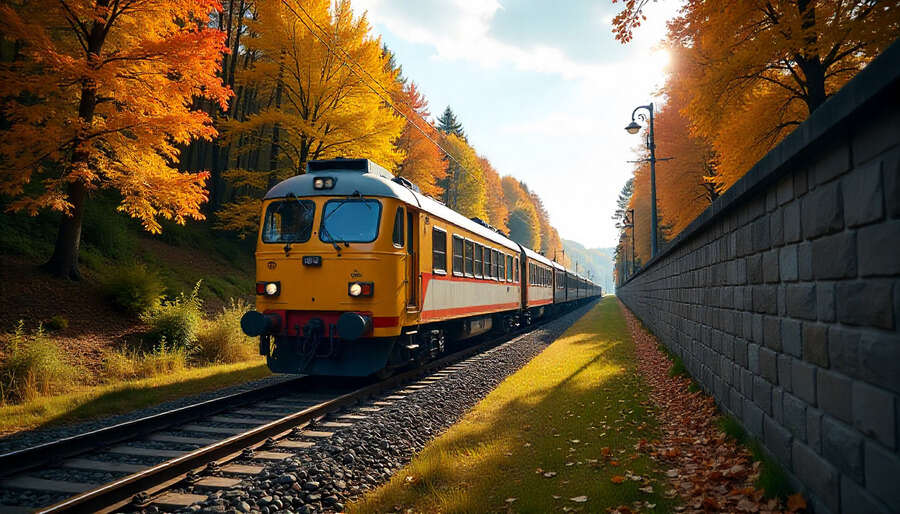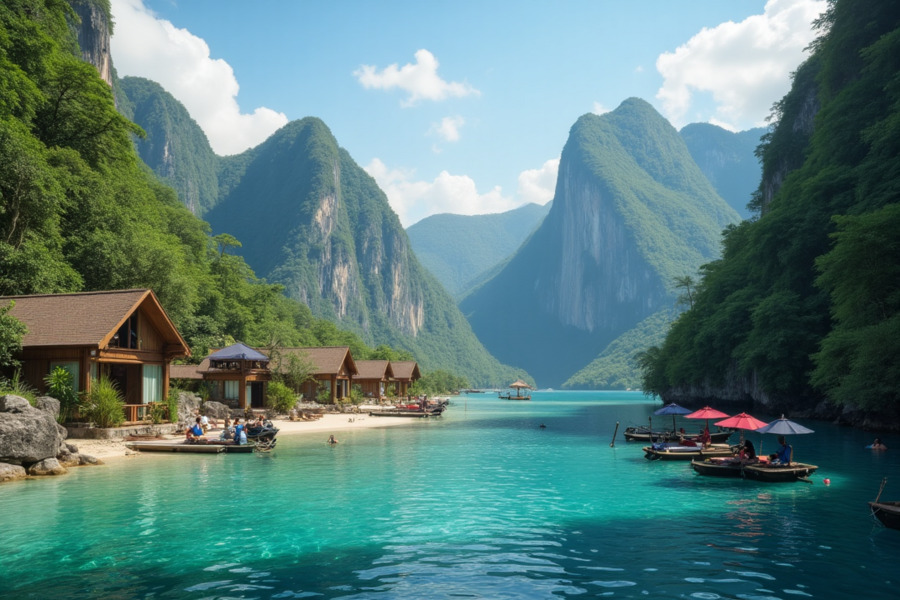≡-Canadian Tourism Benefits from The Ongoing Popularity of Sustainable Rail Travel Across Scenic Routes – Viral of Today
<> Viral of Today <>
Home » Canada Travel News » Canadian Tourism Benefits from The Ongoing Popularity of Sustainable Rail Travel Across Scenic Routes Published on
September 4, 2025Canadian tourism positively benefits from the ongoing popularity of sustainable rail travel on scenic routes. It assists travelers with an additional eco-friendly option on how to explore the breathtaking beauty of the land. There is nothing better than eco-friendly rail travel across the Rockies and other remote northern areas of Canada. VIA Rail’s expansive cross-country routes and the luxurious Rocky Mountaineer both captivate eco-conscious travelers seeking leisurely and immersive experiences amidst Canada’s stunning landscapes. Demand for Canadian tourism is still strong for preserved routes and modern high-speed rail networks. Eco-conscious and rail travel is on the rise. Supply for remarkable travel experiences is being satisfied.The Canadian Rail System, like the rest of the world, has a rich history and the ability to transition from a nationalism core to the major branch of a luxurious touristic industry is remarkable. I believe this is a direct result of the industry’s constant development, from the very first canadian pacific rail, to the modern luxurious trains. The other perspective is keeping the industry in accordance with the rest of the world is the environmental benefits. Similar to other industries, it rail system adopts to modern techniques like switching from cars to trains and planes to be more accessible and to act more as a sustainable and eco-friendly option.The History and Legacy of Rail Travel in CanadaCanada’s rail story began with the monumental completion of the Canadian Pacific Railway in 1885. This feat of engineering was pivotal in shaping the country’s development, both in terms of settlement and tourism. The completion of the railway allowed people and goods to traverse the nation’s vast expanse, which was previously only accessible by challenging land and water routes. The railway became the backbone of Canada’s economic growth and development in the late 19th and early 20th centuries.Though the rise of the automobile led to a decline in passenger rail travel for many years, rail has never entirely disappeared from the Canadian landscape. The legacy of the railway continues to thrive in a different form today—through scenic train journeys, heritage routes, and luxury experiences that offer a connection to the past while providing modern, sustainable travel options for the future.VIA Rail: Connecting Canada Through Remote AreasVIA Rail is the primary rail service provider in Canada, operating passenger trains across the country and offering travelers the opportunity to explore remote, often inaccessible regions of the nation. For many, VIA Rail represents not just a mode of transport but an experience in itself—an opportunity to enjoy stunning views, comfort, and the unique charm of train travel.VIA Rail’s network spans over 12,000 kilometers, including key routes that connect major urban centers and remote regions. Whether it’s the famous Ocean route traveling from Montreal to Halifax or the cross-country journey between Toronto and Vancouver, VIA Rail allows passengers to experience the vast, diverse beauty of Canada from a train window.The scenic nature of these journeys, especially through areas where road access is limited, makes VIA Rail an ideal travel choice for eco-conscious tourists. Unlike cars and airplanes, trains produce fewer carbon emissions, making them a greener way to explore the country while reducing your environmental impact.Rocky Mountaineer: A Luxurious and Scenic ExperienceOne of the most sought-after luxury rail experiences in Canada is offered by the Rocky Mountaineer. This iconic train journey, which takes travelers through the spectacular Canadian Rockies, has become a bucket-list experience for many. The Rocky Mountaineer is known for its glass-dome coaches that provide unobstructed views of the stunning landscapes of western Canada.Onboard, passengers are treated to world-class service and a luxurious experience, making it more than just a means of transportation—it’s an immersive way to experience the beauty of nature. The journey through the Rockies offers travelers a chance to relax and savor the moment, all while traversing some of Canada’s most scenic and untouched landscapes.The Rocky Mountaineer has become a symbol of sustainable luxury travel. It attracts visitors from around the globe, highlighting the increasing interest in slower, more eco-friendly journeys. As travelers become more conscious of their carbon footprints, the Rocky Mountaineer offers an alternative to air travel, allowing guests to enjoy the journey at a more leisurely pace.Heritage Railways: Preserving Canada’s Rail HistoryWhile modern rail travel continues to evolve, Canada also boasts a rich heritage of railway history. Many heritage railways across the country offer visitors a chance to step back in time and experience the golden age of rail travel.One notable example is Ontario’s Halton County Radial Railway (HCRR), which has been operating since 1954. The museum preserves the history of rail transportation in the region by showcasing restored rolling stock and offering live demonstrations of old streetcars and trains. The HCRR’s commitment to preserving Canadian rail history ensures that future generations will continue to appreciate the role that railroads played in the country’s development.This year marks the 70th anniversary of the Halton County Radial Railway, and to celebrate, a commemorative book has been released documenting its evolution and growth. For editor Caroline Rose, this project was not just about preserving the physical elements of the railway but also educating the public on the cultural significance of rail travel. Understanding the past is essential for appreciating how it influences modern transportation, and preserving rail history allows for greater appreciation of the present and future of sustainable travel.The Environmental Benefits of Rail TravelAs the world grapples with climate change and the need for sustainable practices, rail travel is being reimagined as a practical and eco-friendly alternative to more polluting modes of transport like cars and planes. Trains produce significantly fewer carbon emissions per passenger kilometer compared to cars and planes, making them a greener way to travel.Canada’s commitment to reducing its carbon footprint and promoting sustainability aligns well with the growing popularity of train travel. Whether on luxury scenic routes or remote northern lines, trains offer a slower, more mindful way of exploring the world. The environmental impact of rail travel is much lower than that of air travel, and as people seek more responsible ways to travel, trains continue to offer a compelling alternative.Rail companies are also working toward reducing their environmental impact even further, investing in more efficient and sustainable technologies. For example, electric trains are being introduced in some regions, further reducing the carbon footprint of rail travel. As the demand for sustainable transportation grows, rail is becoming an increasingly important part of the solution to reducing global emissions.The Future of Rail Travel: A Sustainable RevolutionLooking ahead, the future of rail travel in Canada—and globally—appears promising. High-speed rail networks are already transforming the way people travel in countries across Europe and Asia, and there are ongoing discussions about the potential for similar systems in Canada. These high-speed networks allow for rapid, efficient, and sustainable transportation, enabling travelers to cover long distances in a fraction of the time it would take by car or plane.In Canada, the potential for high-speed rail is particularly exciting in densely populated areas, such as the Quebec City-Windsor Corridor. The development of high-speed rail in this region could revolutionize travel between major cities, offering a fast and sustainable alternative to driving or flying. Such projects would not only provide an eco-friendly solution to transportation but also create jobs and stimulate economic growth in the regions they serve.Furthermore, as the global push for sustainability intensifies, rail travel is being integrated into broader efforts to reduce reliance on fossil fuels. By prioritizing investment in rail infrastructure and technology, governments and private companies can help to create a more sustainable and interconnected transportation system.Rail Travel’s Lasting Impact on Sustainable TravelAlong with its core functions since the 19th century, railroad travel still remains a mode of travel for luxury and eco friendly options. Canada has maintained the diversity of its rail offerings including VIA rail’s long distance routes and the scenic luxury Rocky Mountaineer tours while also providing a means for protection and maintenance of the heritage railways.As Canada contiues to modernize its tourism industry, the combination of VIA Rail and the Rockies Mountaineer offers a unique opportunity to enjoy fully professional panoramic scenic travel experience with personalized professional service. These trains open an entire new avenue on the Canadian Rockies, with breathtaking views within and a sustainable tourism approach. Canada demonstrates its dedication to sustainable tourism through its rail services, which provide an eco-friendly alternative to traditional travel by significantly reducing carbon emissions.With its immersion options and lower ecological footprints, rail travel is esssential for the future of Canada since sustainable options is becoming a more prevalent travel factor. Rail travel through the wilderness, lush landscapes, and city centers is a perfect balanced since it caters to both the travelers in addition to the environment.
This information will surprise you!
See also
- Read until the end to discover everything.
- Important information you need to know.
- Interesting facts and helpful tips.
Conclusion
Did you enjoy the news? Keep following us daily!













